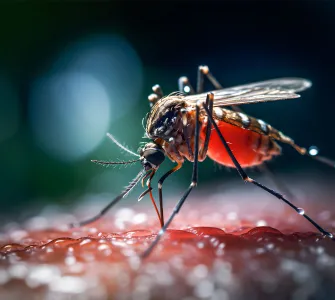Mosquitoes and the tools they use to bite us


Zeroing in
Mosquitoes have an amazing ability to track us down from afar and head straight for our bare skin. To do this, they use a combination of olfactory (smell), visual, and thermal cues to locate our flesh:1
Female mosquitoes have special nerves that can detect carbon dioxide in the air. Because the air we exhale contains more carbon dioxide than normal air, this enables mosquitos to detect humans from a distance2,3
As they get closer, mosquitoes are then able to smell the odors on our skin, allowing them to get within biting range. They do this using thousands of sensory nerves in their antennae, mouthparts, and structures between their antennae and mouthparts, called ‘maxillary palps’2,3,4
Finally, once up close, they can use our body heat to find a suitable landing site.1
Bites and bumps
There are thousands of species of mosquitoes, but a distinguishing feature amongst all of them is the method they use to bite us. The female possesses a tube-like mouthpart, called a proboscis, which is perfectly adapted to pierce our skin and draw blood.5
While obtaining blood from a human, the female mosquito injects some of its own saliva into our skin. The saliva contains substances that prevent our blood from clotting, so that the proboscis does not become trapped in our skin. Upon detecting this injection of saliva, our immune system reacts by releasing histamine and cytokines, substances that cause the itching and hives associated with mosquito bites.5
Hidden dangers
However, the potential danger is caused by what comes next: when a mosquito feeds on us, it also swallows any viruses or parasites living in the blood. These viruses and parasites can live inside the mosquito and can be transferred to the next person the mosquito bites through its saliva. Any disease that is spread in this way from mosquito to human is known as a 'mosquito-borne disease'.6
While the mosquito may not be affected, these mosquito-borne diseases have caused immense suffering for humans throughout history, which are continuing in the present day. It is estimated that millions of people are infected each year with dengue and malaria, and hundreds of thousands more (to varying degrees) are affected by Zika, chikungunya and yellow fever.6,7 Dengue is the most rapidly spreading mosquito-borne viral disease in the world, and cases of dengue have increased over six folds since 2000.8
If you are worried about dengue or have a healthcare-related questions, please contact your doctor or other healthcare professional promptly.
How can I help fight against mosquitoes?
If you want to know what you can do to combat mosquitoes and the threat of dengue, you can read this article: Prevent dengue spreading through your home and community
References
van Breugel, F. et al. Current Biology. 2015;25:2123–2129. Available at: https://www.cell.com/current-biology/fulltext/S0960-9822(15)00740-X. Accessed November 2023.
Herre, M. et al. Cell. 2022 ;195(17):3104-3123. Available at: https://www.cell.com/cell/fulltext/S0092-8674(22)00927-8. Accessed November 2023.
National Institutes of Health. How Mosquitoes Detect People. Available at: https://www.nih.gov/news-events/nih-research-matters/how-mosquitoes-detect-people. Accessed November 2023.
National Institutes of Health. How mosquitoes distinguish people from animals. Available at: https://www.nih.gov/news-events/nih-research-matters/how-mosquitoes-distinguish-people-animals. Accessed November 2023.
Department of Molecular Virology and Microbiology. Mosquito-Borne Diseases. Available at: https://www.bcm.edu/departments/molecular-virology-and-microbiology/emerging-infections-and-biodefense/mosquitoes. Accessed November 2023.
World Mosquito Program. Mosquito-borne diseases. Available at: https://www.worldmosquitoprogram.org/en/learn/mosquito-borne-diseases. Accessed January 2024.
The European Centre for Disease Prevention and Control (ECDC). Available at: https://www.ecdc.europa.eu/en/malaria/facts. Accessed January 2024.
World Health Organization. Dengue and severe dengue: Western Pacific. Available at: https://www.who.int/westernpacific/health-topics/dengue-and-severe-dengue#tab=tab_1. Accessed November 2023.



























